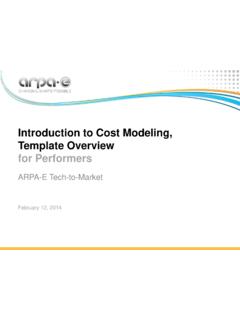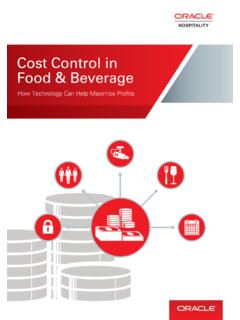Transcription of FM-7024-A Hydrogen Production Cost by AEM White …
1 I N N O V A T I O N S. White PAPER: Hydrogen Production cost by AEM Water Electrolysis 2386 East Mall - Suite 111. Vancouver, BC Canada V6T 1Z3. Ionomr Innovations Inc. 2020. All rights reserved. Document ID: FM- 7024 -B I N N O V A T I O N S. BACKGROUND & INTRODUCTION. Water electrolysis was invented in the 1800s and has been used in industry for Hydrogen Production since the 1920s. With the increase in renewable energy's share of global electricity Production , water electrolysis is a promising solution to produce low-carbon to fully green Hydrogen and connect the sectors of renewable energy, heavy industry, and transportation across the entire energy system. Alkaline Water Electrolysis (AWE) and Proton Exchange Membrane Water Electrolysis (PEMWE) are the two primary methods for Hydrogen Production in commercial use.
2 Alternative methods for green Hydrogen Production including Solid Oxide Water Electrolysis (SOWE) and Photoelectrochemical ( Artificial Leaf') systems remain in the early R&D stage. Between the two commercial technologies, AWE is the more mature, providing durable water electrolysis systems that have been used widely for decades. AWE. offers a distinct advantage of employing low- cost components including inexpensive electrode and porous transport layer materials such as nickel. However, due to the large internal resistance incurred across the thick porous diaphragm and liquid electrolyte employed, AWE. normally operates at low current density (< A/cm2). and efficiency1. As a result of this low areal utilization, AWE requires a bulky stack design at large ( MW).
3 Scales, and stack cost and motility are major contributors to system capital costs (CAPEX). The porous separator necessitates careful pressure balancing of AWE systems. Current density must be altered slowly, and high minimum loads for operation (typically >20-50% of rated power) are required, both causing major challenges to the deployment of these systems for balancing intermittent renewable energy sources such as wind and solar power. A number of water electrolysis manufacturers have developed commercial PEMWE systems that are now available at MW scale. PEMWE systems typically operate at higher current densities (1-3 A/cm2)2, enabling compact designs that can be containerized even at larger scales, providing significant advantages both to manufacturing and on-site deployment.
4 The non-porous nature of the polymeric membrane separator allows for rapid cycling in flexible operational conditions better suited to pairing with intermittent renewables, and provides a speed of response sufficient to replace grid-balancing services. Further, the An alternative electrolysis technology that has recently membrane-type design allows for higher purity Hydrogen gained interest from industrial developers is Anion than AWE, higher initial output pressures, and low Exchange Membrane Water Electrolysis (AEMWE). The minimum loads (typically 5% rated power). However, the design of an AEMWE cell may be conceived either as a use of Platinum-Group Metals (PGM) in the significant enhancement to the properties of AWE. electrocatalyst and in particular, as the separators, both in terms of resistance and corrosion-resistant coating layers on flow components, impermeability, or as a morphing of PEMWE technology raises the PEMWE CAPEX substantially3,4.
5 That allows a similar form-factor and capabilities, with the key difference being AEM systems transport The development of a low-CAPEX electrolysis system hydroxide ions (OH-) instead of protons (H+). This creates would play a vital role in reducing the Production cost of an alkaline electrochemical environment rather than an green Hydrogen . In their current state at the 10-100 acidic environment, enabling significantly more MW-scale, the investment cost for both AWE and cost -effective materials to be employed. As with PEMWE systems are substantially higher than the DOE PEMWEs, AEMWEs may use finely divided metal target ($300/kW). Even with the cost of intermittent catalysts in close contact with a non-porous membrane renewable energy dropping below $ , the capital and two gas transport layers to form a Membrane cost of these deployments is a significant impediment Electrode Assembly (MEA), or, as with AWEs, they may for green Hydrogen to compete with the dominant use strongly alkaline conditions on both electrodes to technology of converting natural gas by Steam Methane provide adequate conductivity to mesh electrodes.
6 Reforming (SMR). Ionomr Innovations Inc. 2020. All rights reserved. Document ID: FM- 7024 -B I N N O V A T I O N S. THE NEED FOR A DISRUPTIVE TECHNOLOGY. AEMWEs can combine and improve upon advantages of both AWE and PEMWE systems. Compared to PEMWE. systems, they operate in dilute liquid alkaline electrolyte instead of pure deionized water, providing tolerance to impurities, flexible electrode design, and an advantage in large systems. AEMWEs can operate at high current densities with differential pressures while using low to zero PGM loadings for the catalyst layers or electrodes. The plenitude of materials choices for corrosion resistance in alkaline media eliminate the need for PGM-coated titanium as the porous transport media and other flow components.
7 In addition, with dilute KOH concentrations ( 1-2 M), shunt currents are substantially reduced for added efficiency and the Balance of Plant (BOP) can be simplified over existing AWE technology with fewer safety concerns and improved material compatibility for supporting equipment. AEMWE is an extremely promising technology to reduce the capital cost of electrolysis systems. However, this technology is currently only available at small scale and in the early stages of development for exploitation at large scales. Instability of key components, in particular membranes, as well as catalysts and electrodes, with additional difficulties of sealing small systems to CO 2. from ambient air, have caused significant obstacles to the commercialization and scaling of AEMWEs to date2.
8 The advantages and disadvantages of the three water electrolysis technologies mentioned above are summarized in Table 1. The advanced alkaline stability recently demonstrated by Ionomr Innovations' Aemion+ TM polymers shows the most promise out of any commercially available AEMs to enhance the stability of AEMWE, and subsequently a platform for optimization of performance of catalysts and electrodes5. Aemion+ TM is the first available commercial material with chemical stability in conditions in excess of the harshest alkaline electrolysis systems (2-3M KOH, 80-100 C), combined with the mechanical strength and consistency to produce large areas. As a result, Aemion+ TM is the enabling, platform material for the scale-up of AEMWE technology to a commercial size.
9 Description AWE PEMWE AEMWE As a nascent commercial technology, performance and economic comparisons of AEMWE systems in relation to Technology + + - both benchmark AWE and PEMWE systems at large readiness scales is not available. In order to raise the profile of the step-change in economic potential of AEMWE for the Non-PGM loading + - + Production of green Hydrogen and the enabling role the newly developed Aemion+ TM membranes play in this Long term stability + 0 - revolutionary technology, Ionomr has invested efforts together with pioneering industrial partners in PEMWE. MW scale + + - and AWE technologies, and leaders in the development and implementation of AEM systems, to evaluate the Compact design - + + economic potential of this technology.
10 The focus of this study is to determine the investment cost of AEMWE. Current density - + + systems when the technology is available at commercial scales comparable to the latest large-scale deployments cost e ective 0 - + of AWE and PEMWE systems. This investment cost is - + applied to determine the Production cost of Hydrogen by Operating pressure + water electrolysis under different electricity supply Non-corrosive scenarios, considering the differences in technical - - + requirements and efficiency among the three water environment electrolysis technologies. Table 1. Advantages & disadvantages of the three water electrolysis technologies Ionomr Innovations Inc. 2020. All rights reserved. Document ID: FM- 7024 -B I N N O V A T I O N S. COMPARISON OF WATER ELECTROLYSIS STACK DESIGN.






